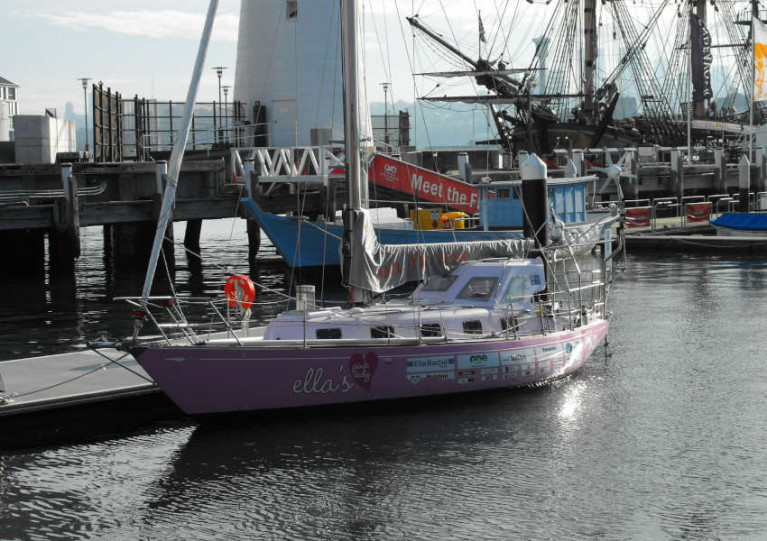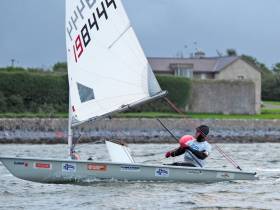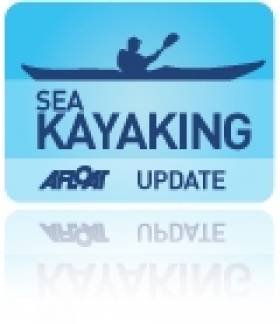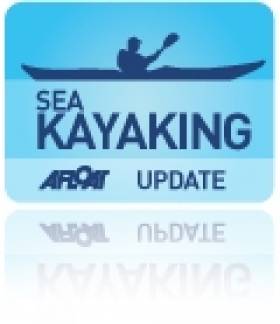Displaying items by tag: circumnavigation
World ARC Circumnavigation Rally Sets Sail
The 13th edition of the World ARC circumnavigation rally set sail on 13 January from Rodney Bay, Saint Lucia, under bright blue Caribbean skies.
For the 27 yachts, the first destination is Santa Marta in Columbia, before heading through the Panama Canal and on into the Pacific.
The fleet enjoyed a Force 5 north easterly for the start, with many opting for a reef - there's 26,000 nautical miles to cover over the next 15 months and World ARC isn't a race. Ian and Jacqueline Kirkpatrick's Shipman 63 Fatjax (GBR) was first over the line, followed by Jeanneau Sun Odyssey 49 Bahati (GBR) and Sundeer 64 Crazy Horse (USA).
From onboard his Moody 54 Dilema, Tom Ogilvie said: "We were all buzzing as we crossed the line. Pre-start tension behind us and a good breeze in the sails - long may it continue!".
Rally supporters on the water to wave off friends and family included Saint Lucia's Minister of Tourism, Investment, Creative Industries, Culture and Information, the Honourable Dr Ernest Hilaire, who spoke to the fleet via VHF radio: "You're looking fantastic out there. I want to say a special thank you to everyone. I wish I could be in your rally, but someone has to be here to welcome you back in 2025!"
Lane Jacobs, owner of Bristol 57 Corsair (USA), sums up the aspirations of many sailors: "I've wanted to sail around the world since 1976, and its taken me almost 50 years to learn to sail, save the money, get the right boat and find the time to do it. I can't tell you how happy I am to be here at last for the start of World ARC".
The first arrivals are expected in Santa Marta, Colombia on the evening of Tuesday 16 January. One-off Roger Hill Yacht Design catamaran Nica (DEU) is leading the fleet, followed by Oyster 62 Skyelark 2 (GBR). The forecast is for strong trade winds, and all boats are making good time on the 815 nautical mile passage.
From Santa Marta the fleet will explore the San Blas Islands of Panama, before a Panama Canal transit in February and on into the Pacific to Galapagos, French Polynesia and Oceania.
Helmut and Babsi Lexen are joining World ARC for a second circumnavigation, this time in their new Nautitech 482 Freya (DEU). "This is the second time we've done World ARC. We love it so much, particularly the camaraderie among the sailors. Our favorite destination, which we can't wait to return to, is Fakarava in French Polynesia".
A total of 37 yachts will take part in the rally over the next 15 months as it sails around the world, with the option of breaking the rally half way in Australia or Indonesia to extend the adventure with independent exploration. 14 yachts will leave the rally in Australia or Indonesia with another 11 joining, the majority of which took part in World ARC 2023.
19 of the yachts starting from Saint Lucia sailed with World Cruising Club across the Atlantic, crossing with the 2022 or 2023 editions of the ARC and ARC Plus rallies.
In the week before the start, the crews assembled in Rodney Bay Marina for safety checks, routeing and weather seminars, and the social events that build the friendships and camaraderie that define the rally. World Cruising Club Managing Director, Paul Tetlow said: "We have an enthusiastic and well-prepared group of sailors, and the World Cruising Club team are looking forward to supporting them of their adventure of a lifetime.
"It's been a wonderful week in Saint Lucia. We couldn't have asked for a better destination to launch the World ARC rally, and we thank the team at IGY Rodney Bay Marina and Saint Lucia Tourism for their marvellous support".
Late starters for leg one include Axonite (NLD), Abide (GBR) and Crazy Horse (USA), all of which are expected to be underway in the next day. Esperanza (USA) will join the fleet in Santa Marta.
Sixteen yachts are already signed-up for the next edition of World ARC, which will set sail from the Caribbean in January 2025.
The Irish Whale and Dolphin Group (IWDG) is backing Limerick sailor Peter Lawless’ pending solo, non-stop round-the-world voyage on his Rival 41 yacht Waxwing.
While the charity has sponsored the yacht’s passive self-steering equipment, in return Peter — son of the late solo circumnavigator Pat Lawless — will be testing out the IWDG’s new reporting app for marine wildlife sightings.
As previously reported on Afloat.ie, sightings and strandings can be reported on the new app by scientists, researchers, boat operators, wildlife enthusiasts and whale-watchers alike.
And Peter — who sets off from Kilrush on 21 August — aims to take the app into the unknown, potentially recoding sightings and even video updated from parts of the ocean that may have never been visited before.
The IWDG’s chief Simon Berrow recently caught up with Peter on Waxwing as he makes his final preparations for his remarkable unassisted voyage:
Claims That Would-Be Round-the-World Record-Setter’s Yacht Left to Rot by Maritime Museum
Mail Online is reporting that the yacht used by would-be round-the-world record-setter Jessica Watson has been left to rot outside the maritime museum where it has resided for almost a decade.
In 2009, then 16-year-old Watson, from Australia, sailed her yacht Ella’s Pink Lady around the globe in 210 days to unofficially become the youngest circumnavigator. The feat also saw her named as 2011’s Young Australian of the Year.
That same year the distinctive pink yacht was jointly purchased by Queensland and Australian governments for AUS$300,000, with the intention of a permanent exhibition dedicated to Watson’s feat at the Queensland Maritime Museum.
However, it’s now being claimed that Ella’s Pink Lady is lying all but abandoned on the museum’s grounds, with the hull leaking and riddled with mould.
And a marine auctions expert estimates that the famous boat is worth a fraction of its 2011 sale price. Mail Online has more on the story HERE.
In 2012, Watson’s claimed record was beaten by 16-year-old Dutch sailor Laura Dekker by some eight months, as previously reported on Afloat.ie.
Inland Cruiser ‘Arthur’ Completes Historic Four-Month Circumnavigation Of Ireland
Richard Hayes’ Laser isn’t the only small boat to complete a circumnavigation of Ireland in recent days.
This past Monday (24 September), the crew of Arthur — a 40-year-old inland motor cruiser based in Portumna on the River Shannon — finished their own historic rounding of the island of Ireland over four months at sea.
Arthur began its journey out of the river in June, cruising past Limerick and Kilrush through the Shannon Estuary and heading southwards in an anti-clockwise direction.
Top passage planning by the crew meant their vessel, built for the lesser rigours of more sheltered inland waterways, was able to withstand the winds and sea state around some tricky parts of the Irish coastline, particularly along the Wild Atlantic Way.
Tomorrow afternoon (Friday 28 September), members of the Inland Waterways Association of Ireland will welcome Arthur and crew back to the inland Shannon from 3.30pm in Killaloe, at the canal moorings next to the Co Clare village’s tourist office.
And if you’re in the region you might catch Arthur’s passage along the way, as boat and crew are scheduled to arrive at Limerick’s Sarsfield Lock at 11.20am, followed by the world’s second-deepest lock, at Ardnacrusha, at 1pm.
Galway Bay Sailor Rounds Ireland By Laser
#Laser - The Galway Advertiser is reporting that Galway Bay Sailing Club member Richard Hayes has completed a solo circumnavigation of Ireland by Laser dinghy.
Hayes sailed 54 days over three-and-a-half months since 27 May to complete the near 2,500km challenge last Friday 14 September in aid of heart and stroke charity Croí — and he is still raising funds for the remarkable effort online.
“This is one of the smallest boats ever to have circumnavigated Ireland and to have successfully done so without a support team on the water,” Hayes shared on Facebook of the achievement.
W M Nixon's Sailing On Saturday this weekend (22nd September) takes a detailed look at Richard Hayes’ great achievement, and other notable small boat voyages round Ireland
Round-Ireland Kayaker Has Sights Set On Biggest Goal Yet
#Kayaking - A German woman who circumnavigated Ireland by kayak in 2016 is taking the story of her remarkable global padding adventures on tour across Europe, as the Irish Examiner reports.
Freya Hoffmeister recently returned to Ireland to give talks in Dublin and Cork on her epic solo kayaking voyage around South America, which she undertook in sections over more than 30 months between 2011 and 2015.
Before that, she paddled around Iceland in what’s regarded as the ‘K2 of sea kayaking’, and took on New Zealand’s South Island that same year.
The speaker and endurance athlete also holds a circumnavigation of Australia among her host of achievements — with her next being the mammoth undertaking of North America, which will require kayaking through the treacherous Northwest Passage.
But as lofty as these goals might seem to the average human, Freya brings things down to earth in her motivational talks, on which the Irish Examiner has more HERE.
Enda O'Coineen Will Not Be First Irish Solo Circumnavigator
The current Vendee Globe Race non-stop round the world is deservedly attracting enough attention without having to make over-stated claims on behalf of some of its participants writes W M Nixon.
The official website is today carrying a story that if Enda O’Coineen can succeed in his plan of sailing his dismasted IMOCA 60 Kilcullen Voyager from Dunedin at the south end of New Zealand under jury rig to Auckland 800 miles away to the north, where a loaned replacement masts awaits, then if he can continue the voyage back to les Sables d’Olonne round Cape Horn he will become the first Irishman to sail solo round the world.
Not so. Noted Dublin marine artist Pete Hogan, who sailed solo round the world in his gaff ketch Molly B, said today that the number of misapprehensions about who was first doing what in the Irish circumnavigation stakes is astonishing.
For instance, when he rounded Cape Horn in the 1990s, he was acclaimed as the first Irishman to do it alone, for of course Conor O’Brien had done it with the crewed Saoirse in 1925. Yet Pete Hogan found it very difficult to get anyone to listen when he subsequently tried to set the record by saying that Bill King of Galway with the junk-rigged ketch Galway Blazer was the first solo, and that was way back in 1973.
The fact that Bill King was a distinguished former British submarine commander may have projected the image of being non-Irish. But in fact he flew both the Irish tricolour and the
British red ensign, and his home was Oranmore Castle at the head of Galway Bay.
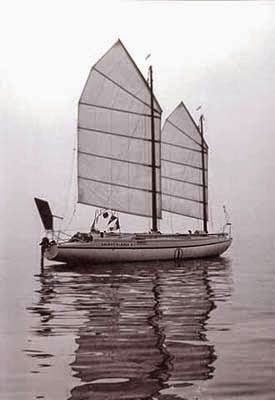 Bill King’s purpose-designed Galway Blazer circumnavigated the world solo south of the great Capes in 1973.
Bill King’s purpose-designed Galway Blazer circumnavigated the world solo south of the great Capes in 1973.
Since then, other Irish sailors who have striven to circumnavigate include Declan Mackell, originally from Portaferry but Canadian-based by the time he undertook his voyage in a Contessa 32, with which he returned home to Ireland for a prolonged stay during his circuit.
Another lone circumnavigator, Pat Lawless of Limerick who completed his voyage with a Seadog ketch in 1996 at the age of 70, had hoped to take in Cape Horn, but rigging damage forced him into a Chilean port, and eventually he returned to Ireland via the Panama Canal. But his circuit was definitely completed, and completed alone.
And Pete Hogan believes there may be one or two other Irish lone circumnavigators who have done it without fanfare. For not everyone seeks the kind of publicity which the Vendee Globe inevitably provides.
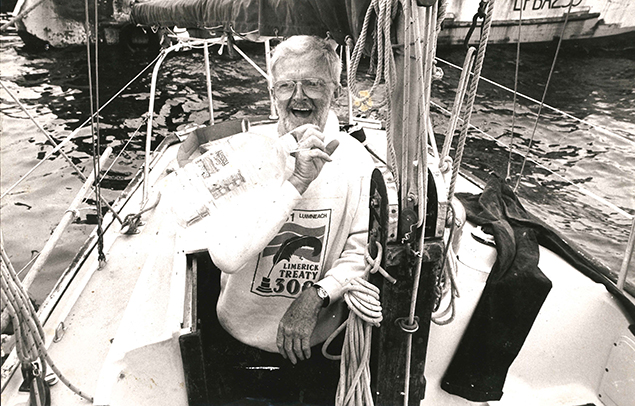 Limerick circumnavigator – the irrepressible Pat Lawless aboard his world-girdling Seadog ketch
Limerick circumnavigator – the irrepressible Pat Lawless aboard his world-girdling Seadog ketch
New Round-Ireland Kayaking Record In The Offing
#Kayaking - It hasn't been the best summer for long-distance kayaking in Ireland, what with Manx duo Keirron Tastagh and George Shaw being forced to abandon their round-Ireland effort three weeks ago.
And that's not to mention exhaustion getting the better of pizza-oven maker Hendrik Lepel on the first leg of his voyage from Kinsale to Germany.
But two expeditions currently under way may have better chances as the weather improves.
The42.ie brings news of Jon Hynes and Sean Cahill's "once in a lifetime" kayaking trip round Ireland, which began on 16 June near the former's Kinsale home.
Taking a clockwise route around the island of Ireland, as of yesterday (Tuesday 30 June) the pair were taking shelter in Broadhaven Bay, Co Mayo awaiting a break in the weather to proceed to Donegal and on to the north coast and the half-way mark.
“It's definitely the pinnacle of expedition kayaking when you’re trying to get around Ireland in this type of weather!" said Hynes, who can boast of some 60 years of kayaking experience between him and Cahill.
However, ahead of them is an even more elite kayaker in the form of Waterford man Mick O'Meara, who as of yesterday was just four days shy of setting a brand new speed record for a solo circumnavigation of Ireland, as The Irish Times reports.
If O'Meara - a multiple-time Liffey Descent winner – reaches his hometown of Tramore by this Friday 3 July, he will have shaven two days off the record set by Jeff Allen and Harry Whelan on the 1,200km voyage in 2011.
#Kayaking - A duo of paddlers from the Isle of Man are getting ready to set a new round-Ireland sea kayaking record.
As BBC News reports, Keirron Tastagh and George Shaw aim to cover as many as 50 nautical miles a day in their standard seagoing kayaks to break the current 28-day record and raise funds for the RNLI.
And they've warmed up for the challenge appropriately, kayaking from their home in the Irish Sea to Northern Ireland as the start of their clockwise circumnavigation, beginning at Strangford in Co Down.
Experienced kayakers Tastagh and Shaw are already record breakers, after setting the furthest paddle west from Dutch Harbour – famous from the TV series Dangerous Catch – to Herbert Island in the Aleutians.
They're also not the first to attempt a circumnavigation this summer, as the Ogden brothers will set off from Baltimore over the June bank holiday in their 18ft Drascombe Lugger.
BBC News has more on the story HERE.
Derry-Born Surf Kayak World Champ Gets Congrats From Home
#Kayaking - Derry Mayor Martin Reilly offered his congratulations to native son Jake King on taking the surf kayak world title in Australia earlier this month.
As the Derry Journal reports, 18-year-old King was crowned champion after topping three other reigning top dogs in the men's longboat, masters and junior short boat in the final of the competition at Maroochydore beach in Queensland.
According to his father Paddy, Jake King can now add his name to the list of five previous world champions from the Canoe Association of Northern Ireland (CANI) surf kayak club - which includes his brother Corin.
In other kayaking news, a London paddler has broken the record for circumnavigating the Isle of Man in the Irish Sea.
BBC News reports on the feat achieved by 39-year-old George Shaw, who completed the 115km route around the island in 11 hours 43 minutes - smashing the previous record by almost an hour.


























